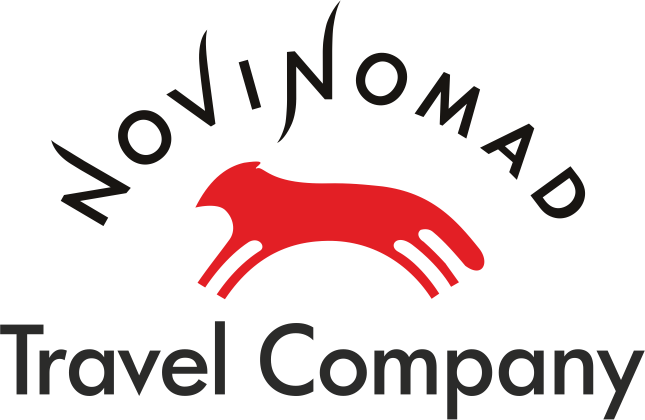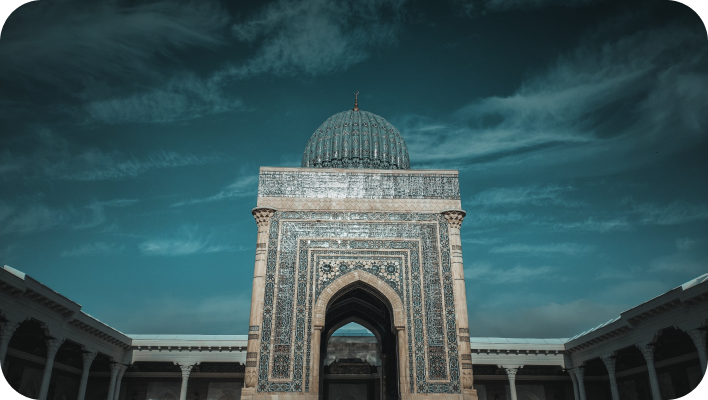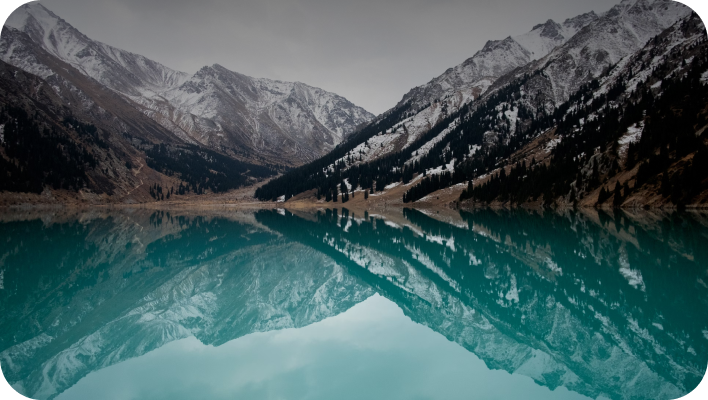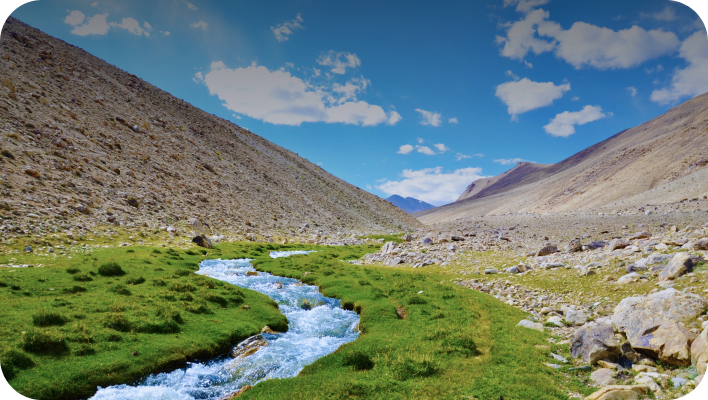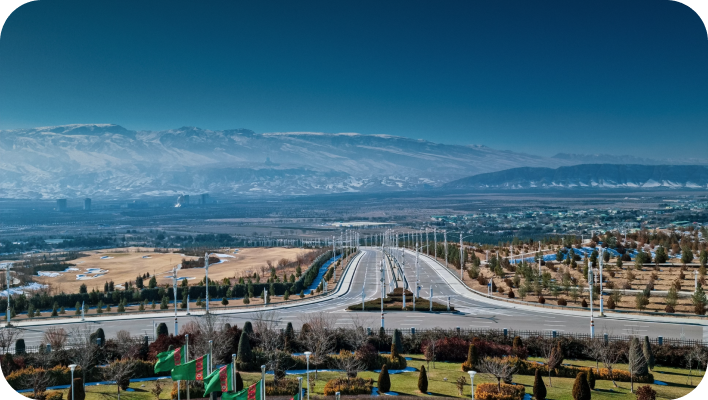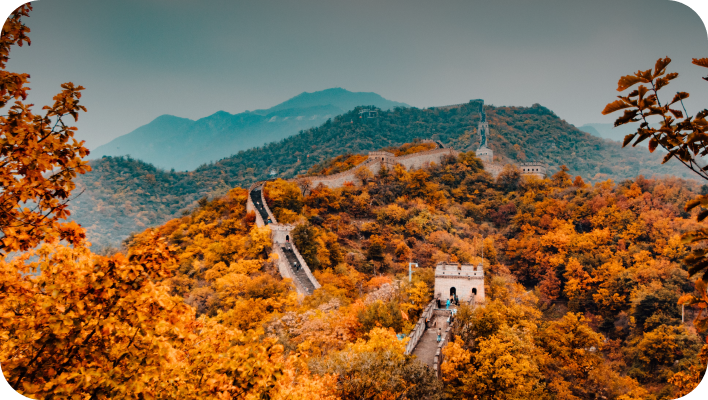General information about Kyrgyzstan
Kyrgyzstan — a magical place with shades of Shangri-la or The Lost World. Maybe those masters of prose who wrote such masterpieces had visited or heard of this legendary mountain kingdom. Unlike its Himalayan or South American counterparts of literary fame, Kyrgyzstan — or The Kyrgyz Republic to give it its official title — is real, but its beauty and untamed wildness are the stuff of oral legends.
It is said that everything in life can be found in Kyrgyzstan both physically and geographically. There are flat steppes, arid deserts, green, rolling foothills, plunging ravines with turbulent, frothing rivers, waterfalls cascading from the sides of sheer mountain faces, wondrous nut and fir forests full of some of the most beautiful — and endangered — species in the world, endless grass-covered high mountain pastures, alpine meadows that make Switzerland’s meadows look like small well-tended parks and staggeringly beautiful snow-covered mountain peaks sitting atop some of the most difficult — and rewarding — climbs in the mountaineering world. This is a land where vultures and eagles soar.
Seeing is believing and the only way you can ever experience the true delights of this small, secluded mountainous country — by Asian standards — is to visit it. Words alone cannot do justice to the variety of sights and sounds — and truly awesome silences — that await you.
Location
Kyrgyzstan lies at the very heart of Central Asia surrounded by the mighty expanses of China, Kazakhstan Uzbekistan and Tajikistan. It covers an area of 198,500 sq. km. and its longest borders run 925 km from west to east and 454 km from north to south. The topography and geography of the country lends itself to a North-South divide, with the main concentrations of population/business in the north and south, with an almost uninhabited interior.
Time
GMT + 6 hours. Kyrgyzstan does not operates Daylight Saving Time.
Almaty (Kazakhstan) to Kyrgyz time is same
Tashkent (Uzbekistan) to Kyrgyz time – 1 hour
Beijing (China) to Kyrgyz time + 2 hours
Moscow (Russia) to Kyrgyz time – 3 hours
Climate
The mountainous terrain, remoteness from any oceans and being surrounded by deserts, gives Kyrgyzstan what can only be described as a harsh continental climate, with large changes in temperature occurring in a short period of time. The wettest place is the west slope of the Ferghana Range with 1,000 mm, whilst the driest is Balykchy on the western tip of Issyk-Kul Lake with 100 mm of precipitation. The average temperature throughout the country in January varies between — 4 to — 14 C and in July between + 12 to + 40 C and there is an average of 247 days of sunshine a year.
Landscapes
The fact that 94% of Kyrgyzstan is covered in mountains produces great variations in the geographical, topographical and natural appearance of the country. The lowest valley floor is itself 500 metres above sea level and the highest peaks soar to more than 7,000 metres above sea level in the mighty Tien Shan Range. These mighty peaks are world renowned and are part of the exclusive list of 7,000 metre plus peaks of the world — Pobeda Peak (Victory Peak) 7,439m, Lenin Peak 7,134m and the legendary Khan-Tengry (7010m) — the white/pink marble pyramid held sacred by the Kyrgyz through the ages.
Mountain lakes abound and arguably one of the most beautiful sets of lakes anywhere in the world can be found at Sary Chelek in a national park. To see this is to behold the true beauty of nature. The ‘Pearl of the Heavenly Mountains’ — or Issyk-Kul Lake — is the second largest high mountain lake in the world, second only to Lake Titicaca in size and is so big it has its own unique biosphere. Although forests cover only a small area of Kyrgyzstan the truly unique indigenous walnut tree forests of Arslan-bob are worth any sort of journey to see.
Flora and fauna
The flora and fauna here are both unique and plentiful, ranging from exquisite semi-tropical tulips to stunningly beautiful alpine edelweiss — yes Kyrgyzstan is not known as the ‘Switzerland of Asia’ for nothing and the vitamin content of herbs are second to none in the world, far exceeding those of the famed herbs of Georgia beloved of perfume and medicinal companies of the west! There is even a unique fir tree — the Tien Shan Spruce.
The number and range of birds of prey has to be seen to be believed and travellers to the more remote parts of the country will be amazed at how close it is possible to approach these magnificent animals if one is careful. Although they should probably be counted as domestic animals, it should be noted that camels and yaks are also to be found in the higher areas and plans are afoot to dramatically increase the breeding of yaks.
To do full justice to the wonderful range of flora and fauna would take far more space than is available here — so, again, please come and see for yourself — you will not be disappointed!
Population
The official statistics says about 6 millions of inhabitants. And among them are Kyrgyz 72,8%; Uzbek 14,5%; Russian 6,2% and other nationalities 6,5% (Germans, Ukrainians, Kazakhs, Koreans, Tatars, Tajiks, Uighirs and Dungans). The average density for the whole country is 30 people per square kilometre, although Ferghana Valley is extremely overcrowded.
Language
The official language is Kyrgyz but the State language is Russian. Recently, a new law was adopted whereby Kyrgyz has become the State language. History has left a legacy that means that in the north around Bishkek Russian is the dominant language but in the villages and the South Kyrgyz is the everyday language.
Religion
Kyrgyzstan is a very tolerant nation and allows freedom of worship to everyone and there are more than 100 different religious sects/philosophies active in the country. Its interdenominational council is being studied worldwide as an example of how to create and promote religious tolerance and harmony. The Kyrgyz are Muslim but it has to be said that a lot of them practice it in their own way. Official statistics indicate; Muslim 80%; Russian Orthodox 17%; Others 3%.
Political system
Kyrgyzstan has its own Constitution, President, Prime Minister, Cabinet of Ministers and Parliament (Jogorku Kenesh).
The President holds the reins of power through the President’s Administration and can dissolve the Cabinet of Ministers at will and the Prime Minister has very limited, almost token, powers
Administrative divisions
The country is still divided under the system laid down in Soviet times.
The administrative regions are:
Oblast — Kyrgyzstan is divided into 7 Oblasts (provinces) each with its own Governor (gubernator) and each oblast is further subdivided into Rayons, (districts) (40 in total).
The capital Bishkek is recognised as a separate entity in total and has its own administration etc.
Economy
Since the collapse of the Soviet Union the economy has undergone massive changes and is still evolving. The central supply driven economy has been totally replaced by a free market economy. This has entailed several distinct phases, which have all had their pluses and minuses. Agriculture was and still is the largest employer of people in the Kyrgyz economy. Land reforms in Kyrgyzstan have progressed further and faster than anywhere else in the CIS and the result has been a bit of a mixed bag. Kyrgyz citizens meeting certain clearly defined criteria have received land shares (plots of land) as private property. Since the collective farms were broken up and people formed their own flocks, a great number of the national flock of sheep have been killed but now numbers are increasing again as the value of the flock as a source of income is becoming more and more apparent. This also applies to other farm animals such as horses.
There are natural resources, in particular water and that has led to the development of the hydro electricity industry and several substantial plants are due to be completed in the next few years. Electricity exports continue to grow every year and are really only restricted by the limited load capacity of the HT lines from the country. However, unlike the other Central Asian states, Kyrgyzstan does not have large reserves of oil and gas. There are large coal reserves but at present access is very difficult and transport costs make them impossible to market. However, when the projected China — Iran — Europe Railroad is built these resources should be much more exploitable. Gold is one resource much in demand and there are currently 130 plus prospecting/mining companies active in the country. A major resource, uranium, is no longer in such great demand on the world market.
Kyrgyzstan lies at the very heart of Central Asia surrounded by the mighty expanses of China, Kazakhstan Uzbekistan and Tajikistan. It covers an area of 198,500 sq. km. and its longest borders run 925 km from west to east and 454 km from north to south. The topography and geography of the country lends itself to a North-South divide, with the main concentrations of population/business in the north and south, with an almost uninhabited interior.
GMT + 6 hours. Kyrgyzstan does not operates Daylight Saving Time.
Almaty (Kazakhstan) to Kyrgyz time is same
Tashkent (Uzbekistan) to Kyrgyz time – 1 hour
Beijing (China) to Kyrgyz time + 2 hours
Moscow (Russia) to Kyrgyz time – 3 hours
The mountainous terrain, remoteness from any oceans and being surrounded by deserts, gives Kyrgyzstan what can only be described as a harsh continental climate, with large changes in temperature occurring in a short period of time. The wettest place is the west slope of the Ferghana Range with 1,000 mm, whilst the driest is Balykchy on the western tip of Issyk-Kul Lake with 100 mm of precipitation. The average temperature throughout the country in January varies between — 4 to — 14 C and in July between + 12 to + 40 C and there is an average of 247 days of sunshine a year.
The fact that 94% of Kyrgyzstan is covered in mountains produces great variations in the geographical, topographical and natural appearance of the country. The lowest valley floor is itself 500 metres above sea level and the highest peaks soar to more than 7,000 metres above sea level in the mighty Tien Shan Range. These mighty peaks are world renowned and are part of the exclusive list of 7,000 metre plus peaks of the world — Pobeda Peak (Victory Peak) 7,439m, Lenin Peak 7,134m and the legendary Khan-Tengry (7010m) — the white/pink marble pyramid held sacred by the Kyrgyz through the ages.
Mountain lakes abound and arguably one of the most beautiful sets of lakes anywhere in the world can be found at Sary Chelek in a national park. To see this is to behold the true beauty of nature. The ‘Pearl of the Heavenly Mountains’ — or Issyk-Kul Lake — is the second largest high mountain lake in the world, second only to Lake Titicaca in size and is so big it has its own unique biosphere. Although forests cover only a small area of Kyrgyzstan the truly unique indigenous walnut tree forests of Arslan-bob are worth any sort of journey to see.
The flora and fauna here are both unique and plentiful, ranging from exquisite semi-tropical tulips to stunningly beautiful alpine edelweiss — yes Kyrgyzstan is not known as the ‘Switzerland of Asia’ for nothing and the vitamin content of herbs are second to none in the world, far exceeding those of the famed herbs of Georgia beloved of perfume and medicinal companies of the west! There is even a unique fir tree — the Tien Shan Spruce.
The number and range of birds of prey has to be seen to be believed and travellers to the more remote parts of the country will be amazed at how close it is possible to approach these magnificent animals if one is careful. Although they should probably be counted as domestic animals, it should be noted that camels and yaks are also to be found in the higher areas and plans are afoot to dramatically increase the breeding of yaks.
To do full justice to the wonderful range of flora and fauna would take far more space than is available here — so, again, please come and see for yourself — you will not be disappointed!
The official statistics says about 6 millions of inhabitants. And among them are Kyrgyz 72,8%; Uzbek 14,5%; Russian 6,2% and other nationalities 6,5% (Germans, Ukrainians, Kazakhs, Koreans, Tatars, Tajiks, Uighirs and Dungans). The average density for the whole country is 30 people per square kilometre, although Ferghana Valley is extremely overcrowded.
The official language is Kyrgyz but the State language is Russian. Recently, a new law was adopted whereby Kyrgyz has become the State language. History has left a legacy that means that in the north around Bishkek Russian is the dominant language but in the villages and the South Kyrgyz is the everyday language.
Kyrgyzstan is a very tolerant nation and allows freedom of worship to everyone and there are more than 100 different religious sects/philosophies active in the country. Its interdenominational council is being studied worldwide as an example of how to create and promote religious tolerance and harmony. The Kyrgyz are Muslim but it has to be said that a lot of them practice it in their own way. Official statistics indicate; Muslim 80%; Russian Orthodox 17%; Others 3%.
Kyrgyzstan has its own Constitution, President, Prime Minister, Cabinet of Ministers and Parliament (Jogorku Kenesh).
The President holds the reins of power through the President’s Administration and can dissolve the Cabinet of Ministers at will and the Prime Minister has very limited, almost token, powers
The country is still divided under the system laid down in Soviet times.
The administrative regions are:
Oblast — Kyrgyzstan is divided into 7 Oblasts (provinces) each with its own Governor (gubernator) and each oblast is further subdivided into Rayons, (districts) (40 in total).
The capital Bishkek is recognised as a separate entity in total and has its own administration etc.
Since the collapse of the Soviet Union the economy has undergone massive changes and is still evolving. The central supply driven economy has been totally replaced by a free market economy. This has entailed several distinct phases, which have all had their pluses and minuses. Agriculture was and still is the largest employer of people in the Kyrgyz economy. Land reforms in Kyrgyzstan have progressed further and faster than anywhere else in the CIS and the result has been a bit of a mixed bag. Kyrgyz citizens meeting certain clearly defined criteria have received land shares (plots of land) as private property. Since the collective farms were broken up and people formed their own flocks, a great number of the national flock of sheep have been killed but now numbers are increasing again as the value of the flock as a source of income is becoming more and more apparent. This also applies to other farm animals such as horses.
There are natural resources, in particular water and that has led to the development of the hydro electricity industry and several substantial plants are due to be completed in the next few years. Electricity exports continue to grow every year and are really only restricted by the limited load capacity of the HT lines from the country. However, unlike the other Central Asian states, Kyrgyzstan does not have large reserves of oil and gas. There are large coal reserves but at present access is very difficult and transport costs make them impossible to market. However, when the projected China — Iran — Europe Railroad is built these resources should be much more exploitable. Gold is one resource much in demand and there are currently 130 plus prospecting/mining companies active in the country. A major resource, uranium, is no longer in such great demand on the world market.
Travel information
Shopping
The retail market, especially in Bishkek, continues to develop apace and there are now several modern shopping complexes and supermarkets and lots of individual specialist boutiques selling mainly imported food, clothes, footwear, electronic goods etc.
For lovers of the exotic, the bazaars are open 7 days a week.
There are also several bazaars selling literally everything and the Dordoi Bazaar on the northern outskirts of the city is in fact the largest market in Central Asia. Buyers come from all over, including Russia, arrive here to purchase goods for wholesale in their own countries. If you have money it is possible to buy virtually anything you could wish for here.
Aside from ordinary shops, there are a host of specialist sstores in Bishkek where you can buy anything you may need, including specialized trekkingt equipment and clothes.
There are lots of pharmacies in the towns and western drugs and medicines are quite freely available but if you need special prescriptions you would be well advised to bring an adequate supply with you. Opticians are everywhere and offer very good services at very good prices compared to Europe/USA.
In specialized food shops in large cities you can buy virtually all your favourite food and drinks.
The majority of shops are open from 9 a.m. till 5 p.m. and some are open 24 hours a day. Supermarkets work from 10 a.m. till 8 p.m. You are advised to go shopping and to the markets with Kyrgyz soms only and no other currencies.
Money
The Kyrgyz Som is freely exchangeable and in Bishkek there are literally hundreds of exchange offices where it is possible to exchange most currencies. These usually offer a better rate than the banks. It is possible to use international credit cards in some places in Bishkek and in some banks you can use your credit card to get money from abroad. Whether you do this or bring cash with you, it is advisable to get either new 100 USD notes (a lot of places will refuse to exchange or offer lower exchange rates for old notes) or minimum Euro 50 notes to exchange. Western Union Money Transfers are possible in the cities. Exchange facilities do not exist in the villages. The som has been remarkably stable over the last couple of years and exchange rates as of November 2024 were 86 som/USD and 91 som/Euro.
Public transport
In Bishkek the best method of public transport is by electrified trolleybuses running between designated stops and costing 20 soms per trip. There are also buses running through the city and a trip in these will cost 20 soms. PLEASE BE AWARE OF PICKPOCKETS AT ALL TIMES on public transport and in shops/stores/markets! Taxis are available on the street or by telephone around the clock but are more expensive at night. Always agree the price before getting in the taxi. In Bishkek, a taxi ride will normally cost between 150 and 350 soms in the daytime. For those who wish to go to other destinations there are bus stations in every big town where you can choose between buses, minibuses (marshrutkas) and taxis. It is possible to share a taxi (usually 4 to a vehicle) and this is usually the quickest way to travel. DO NOT PAY BEFORE YOU ARRIVE AT YOUR DESTINATION!
Photography
The Kyrgyz love having their photograph taken but other nationalities are not so forthcoming and so it is always advisable to ask before taking your camera out. Photography is generally banned in Museums but can usually be arranged for a suitable ‘fee’. Avoid photographing military objects, airports, police and service personnel.
How to get here
You can reach Bishkek directly by the following airlines:
Please note that timetable due to COVID-19 is subject to change and contact airlines for valid schedule.
Conditions of residence
Citizens of following countries from July 2012 no longer need a Kyrgyz visa or have to register with OVIR (the foreigner-registration department)
Austria
Bahrain
Belgium
Bosnia, Herzegovina
Brunei-Dar-As-Salam
Canada
Czech Republic
Croatia
Estonia
Finland
France
Germany
Greece
Hungary
Ireland
Iceland
Korea
Kuwait
Latvia
Liechtenstein
Lithuania
Luxemburg
Malta
Monaco
New Zealand
Norway
Poland
Portugal
Qatar
Saudi Arabia
Singapore
Slovenia
Spain
Sweden
Switzerland
Turkey
United Arab Emirates
United Kingdom
USA
Vatican
Tourists from other countries can obtain a visa from an Embassy or Consular Office of the Kyrgyz Republic, tourism company — if booking a holiday through them — or at Manas (Bishkek) airport on arrival. The cost of a visa varies.
Another possibility to get visa to Kyrgyzstan is e-visa. All informationn on getting this type of the visa you can find on official webpage:
www.evisa.e-gov.kg
Unless a tourist is a citizen of one of the above-listed countries, he/she MUST register with the OVIR office within 3 days of arrival. In case of failure to do so may result in a 25 USD fine.
Overseas diplomatic missions of the Kyrgyz Republic
Belgium
Byelorussia
Canada
China
India
Iran
Kazakhstan
Malaysia
Switzerland
Tajikistan
The Ukraine
Turkey
United Arab Emirates
United Kingdom
USA
Uzbekistan
For complete information please refer to the page of Ministry of Foreign Affairs
Customs and airport taxes
There is no airport tax on internal flights and most international flights. Standard airline rules apply about baggage allowances/excess baggage — check your weight allowances before departure from your home airport.
The retail market, especially in Bishkek, continues to develop apace and there are now several modern shopping complexes and supermarkets and lots of individual specialist boutiques selling mainly imported food, clothes, footwear, electronic goods etc.
For lovers of the exotic, the bazaars are open 7 days a week.
There are also several bazaars selling literally everything and the Dordoi Bazaar on the northern outskirts of the city is in fact the largest market in Central Asia. Buyers come from all over, including Russia, arrive here to purchase goods for wholesale in their own countries. If you have money it is possible to buy virtually anything you could wish for here.
Aside from ordinary shops, there are a host of specialist sstores in Bishkek where you can buy anything you may need, including specialized trekkingt equipment and clothes.
There are lots of pharmacies in the towns and western drugs and medicines are quite freely available but if you need special prescriptions you would be well advised to bring an adequate supply with you. Opticians are everywhere and offer very good services at very good prices compared to Europe/USA.
In specialized food shops in large cities you can buy virtually all your favourite food and drinks.
The majority of shops are open from 9 a.m. till 5 p.m. and some are open 24 hours a day. Supermarkets work from 10 a.m. till 8 p.m. You are advised to go shopping and to the markets with Kyrgyz soms only and no other currencies.
The Kyrgyz Som is freely exchangeable and in Bishkek there are literally hundreds of exchange offices where it is possible to exchange most currencies. These usually offer a better rate than the banks. It is possible to use international credit cards in some places in Bishkek and in some banks you can use your credit card to get money from abroad. Whether you do this or bring cash with you, it is advisable to get either new 100 USD notes (a lot of places will refuse to exchange or offer lower exchange rates for old notes) or minimum Euro 50 notes to exchange. Western Union Money Transfers are possible in the cities. Exchange facilities do not exist in the villages. The som has been remarkably stable over the last couple of years and exchange rates as of November 2024 were 86 som/USD and 91 som/Euro.
In Bishkek the best method of public transport is by electrified trolleybuses running between designated stops and costing 20 soms per trip. There are also buses running through the city and a trip in these will cost 20 soms. PLEASE BE AWARE OF PICKPOCKETS AT ALL TIMES on public transport and in shops/stores/markets! Taxis are available on the street or by telephone around the clock but are more expensive at night. Always agree the price before getting in the taxi. In Bishkek, a taxi ride will normally cost between 150 and 350 soms in the daytime. For those who wish to go to other destinations there are bus stations in every big town where you can choose between buses, minibuses (marshrutkas) and taxis. It is possible to share a taxi (usually 4 to a vehicle) and this is usually the quickest way to travel. DO NOT PAY BEFORE YOU ARRIVE AT YOUR DESTINATION!
The Kyrgyz love having their photograph taken but other nationalities are not so forthcoming and so it is always advisable to ask before taking your camera out. Photography is generally banned in Museums but can usually be arranged for a suitable ‘fee’. Avoid photographing military objects, airports, police and service personnel.
You can reach Bishkek directly by the following airlines:
Please note that timetable due to COVID-19 is subject to change and contact airlines for valid schedule.
Citizens of following countries from July 2012 no longer need a Kyrgyz visa or have to register with OVIR (the foreigner-registration department)
Austria
Bahrain
Belgium
Bosnia, Herzegovina
Brunei-Dar-As-Salam
Canada
Czech Republic
Croatia
Estonia
Finland
France
Germany
Greece
Hungary
Ireland
Iceland
Korea
Kuwait
Latvia
Liechtenstein
Lithuania
Luxemburg
Malta
Monaco
New Zealand
Norway
Poland
Portugal
Qatar
Saudi Arabia
Singapore
Slovenia
Spain
Sweden
Switzerland
Turkey
United Arab Emirates
United Kingdom
USA
Vatican
Tourists from other countries can obtain a visa from an Embassy or Consular Office of the Kyrgyz Republic, tourism company — if booking a holiday through them — or at Manas (Bishkek) airport on arrival. The cost of a visa varies.
Another possibility to get visa to Kyrgyzstan is e-visa. All informationn on getting this type of the visa you can find on official webpage:
www.evisa.e-gov.kg
Unless a tourist is a citizen of one of the above-listed countries, he/she MUST register with the OVIR office within 3 days of arrival. In case of failure to do so may result in a 25 USD fine.
Belgium
Byelorussia
Canada
China
India
Iran
Kazakhstan
Malaysia
Switzerland
Tajikistan
The Ukraine
Turkey
United Arab Emirates
United Kingdom
USA
Uzbekistan
For complete information please refer to the page of Ministry of Foreign Affairs
There is no airport tax on internal flights and most international flights. Standard airline rules apply about baggage allowances/excess baggage — check your weight allowances before departure from your home airport.
Cultural events calendar 2023
Following festivals are planned for summer 2024
National Horse Games Festival by CBT Kyzyl-Oi
National horse games Ulak-Tartysh, Kyz- Kuumai, Er-Enish; Folklore show; Kyrgyz cuisine.
Sulbuurun Festival
Demonstration of hunting skills of golden eagle; falcon Archer’s performance; exhibition of Kyrgyz greyhounds Taigan, exhibition of artists and craftsmen Archery competition among guests, folklore concert
National Horse Games and Birds of Prey Festival by CBT Tamchy
Demonstration of hunting with a Golden Eagle; show of Kyrgyz national games «Ulak-Tartysh” and «Tyiyn-Enmei”
Birds of Prey Festival by CBT Bokonbaevo
Demonstration of hunting with a Golden Eagle; folklore show; national horse games, exhibition and sale of handicrafts and souvenirs; tasting of Kyrgyz cuisine.
Useful links
Ministries of Foreign Affairs
e-visa
Phrase-book
English - Russian - Kyrgyz
| Greetings | Privetstvovanie | Salam-dashuu |
| Good morning | Dobroe utra | Salamatsyzby |
| Good afternoon | Dobriy den | Salamatsyzby |
| Good evening | Dobriy vecher | Salamatsyzby |
| How do you do? | Kak dela? | Ishiniz kandai? |
| How are you? | Kak pojivaete? | Kandai turasyz? |
| Thank you,... | Spasiba,… | Yrakmat,… |
| ...fine | ...harasho | ...jakshy |
| ...not bad | ...ne ploha | ..jaman emes |
| ...so-so | ...tak sebe | ...eptep-septep |
| ...bad | ...ploho | ...jaman |
| GETTING ACQUAINTED | ZNAKOMSTVO | TAANYSHUU |
| What is your name? | Kak vas zavut? | Atyngyz kim ? |
| My name is… | Menya zavut… | Menin atym… |
| Where are you from? | Vy s kakoy strany preyehali? | Siz kaysy mumleketten keldiniz? |
| I am(we are) from… | Ya(my) priyehal (priyehaly) s… | Men(biz)…keldim(keldik). |
| I am very glad. | Ya ochen rad. | Abdan kubanychtumun. |
| Sit down please | Sadites pajalusta. | Oturunguz. |
| Thank you. | Spasiba. | Yrakmat. |
| Excuse me, please. | Izvenite pajalusta. | Kechirip koyunguz. |
| I am sorry. | Mne ochen jal. | Okunushtumun. |
| FAREWELLS | PROSHANIYE | KOSHTOSHUU |
| Good bye. | Dosvidaniya | Kosh bol |
| See you | Uvidimsya | Dagy korushobuz |
| Good luck | Udachi | Ak jol |
| IN THE CITY | V GORODE | SHAARDA |
| How do I get to the…? | Kak mne praiti k…? | …kantip barsa bolot? |
| ...Square | ...ploshadi | Ayantka... |
| ...Center | ...tzentru | Tzentrga... |
| ...Theatre | ..teatru | Teatrga... |
| ...Museum | ...museyu | Museige... |
| ...bus station | ...avtovokzalu | Avtovokzalga... |
| ...hotel | ...gastinitze | Meymankanaga... |
| I have lost my way. | Ya zabludilsya. | Men adashyp kaldym. |
| Where is the taxi stand? | Gde stayanka taksi? | Taksi toktochu jai kaida? |
| AT THE HOTEL | V GASTINITSAE | MEYMANKANADA |
| Where is the nearest hotel? | Gde zdes blijaishaya gastinitza? | En jakyn meymankana kaisy jerde? |
| I need a hotel not far from the center. | Mnye nujna gastinitza nedaleko ot zentra. | Maga centerge jakyn meymankana gerek. |
| My last name is… | Maya familiya… | Menin familiyam… |
| Here is my passport. | Vot moi pasport. | Myna menin pasportum. |
| I need a room for… | Mne nujen…nomer. | Maga…nomer kerek. |
| ...one person | ...odnamestnyi... | ...bir kishilik... |
| ...two people | ...dvoomestnyi... | ...eki kishilik... |
| What’s the price per night? | Skolka stoyit nomer v sutki? | Nomerdin bir sutkalyk baasy kancha turat? |
| What is my room number? | Kakoy nomer? | Kaisy nomer? |
| Is there a…in the hotel? | V gastinitze yest…? | Meymankanada…barby? |
| ...restaurant... | ...restarant | ...restaran... |
| ...post office... | ...pochta | ...pochta... |
| ...telephone... | ...telefon | ...telephone... |
| ...newspaper stand... | ...gazetniy kiosk | ...gazeta kiosku... |
| ...safe... | ...kamera hraneniya | ...kamera hraneniya... |
| IN THE RESTAURANT | V RESTORANE | RESTORANDA |
| Where is there a…? | Gde nahoditsya…? | Kaise jerde…? |
| restaurant | restorant | restoran |
| cafe | cafe | cafe |
| snack bar | zakusochnaya | tez tamak jeri |
| Menu, please. | Daite menu pajalusta. | Menunu berip koyunguzchu. |
| What national dishes do you have? | Kakie natzyalnye bluda u vas yest? | Sizde uluttuk kandai tamaktar bar? |
| What do you have to drink? | Shto uvas yest popit? | Ichkenge emne bar? |
| Bon appetite. | Priyatnogo apetita. | Tamagynyz tattuu bolsun. |
| Give me the bill please. | Daite shot pojaluista. | Shottu berip koyunguzchu. |
| NUMBERS | NOMER | NOMER |
| One | Adin | Bir |
| Two | Dva | Eki |
| Three | Tri | Uuch |
| Four | Chetyri | Turt |
| Five | Pyat | Besh |
| Six | Shest | Alty |
| Seven | Sem | Jeti |
| Eight | Vosim | Segiz |
| Nine | Devyat | Toguz |
| Ten | Desyat | Oon |
| Eleven | Adinazit | Oon Bir |
| Twelve | Dvenazit | Oon Eki |
| Twenty | Dvatzit | Jyirma |
| Thirty | Trizat | Ootuz |
| Forty | Sorok | Kyrk |
| Fifty | Pyadisyat | Eluu |
| Sixty | Shestdisyat | Altymysh |
| Seventy | Semdisyat | Jetimish |
| Eighty | Vosimdisyat | Seksen |
| Ninety | Devyanosta | Tokson |
| One Hundred | Sto | Juz |
| Two hundred | Dvesti | Eki Juz |
| One thousand | Tisyacha | Ming |
